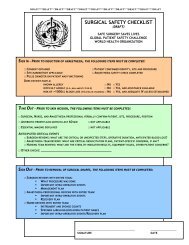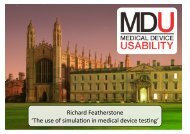The Essentials of Patient Safety - Clinical Human Factors Group
The Essentials of Patient Safety - Clinical Human Factors Group
The Essentials of Patient Safety - Clinical Human Factors Group
Create successful ePaper yourself
Turn your PDF publications into a flip-book with our unique Google optimized e-Paper software.
<strong>The</strong> <strong>Essentials</strong> <strong>of</strong> <strong>Patient</strong> <strong>Safety</strong><br />
Box 1.1 <strong>The</strong> dimensions <strong>of</strong> quality<br />
Safe avoiding injuries to patients from the care that is intended to help them<br />
Effective providing services based on scientific knowledge to all who could benefit<br />
and refraining from providing services to those not likely to benefit (avoiding<br />
underuse and overuse)<br />
<strong>Patient</strong>-centred providing care that is respectful <strong>of</strong> and responsive to individual<br />
patient preferences, needs, and values and ensuring that patient values guide all<br />
clinical decisions<br />
Timely reducing waits and sometimes harmful delays for both those receive and<br />
those who give care<br />
Efficient avoiding waste, in particular waste <strong>of</strong> equipment, supplies, ideas, energy<br />
Equitable providing care that does not vary in quality because <strong>of</strong> personal<br />
characteristics such as gender, ethnicity, geographic location and socioeconomic<br />
status<br />
<strong>Patient</strong> safety reducing harm or reducing error<br />
<strong>Patient</strong> safety is sometimes equated with preventing error (3). This seems innocent<br />
enough, but is a potentially limiting assumption. <strong>The</strong>re is no question that an<br />
understanding <strong>of</strong> error is fundamental to patient safety; however, there are differences<br />
<strong>of</strong> view as to whether the focus <strong>of</strong> patient safety research and practice should be on<br />
error or on harm (4). However, when we consider the overall aim <strong>of</strong> patient safety<br />
there are a number <strong>of</strong> reasons for keeping harm in the forefront <strong>of</strong> our minds.<br />
<br />
<br />
<br />
Harm is what patients care most about. We will all put up with errors in our<br />
care, to some extent at least, as long as we do not come to harm.<br />
Not all harm is due to error. Consider all the myriad forms <strong>of</strong> harm that can<br />
come from healthcare: complications <strong>of</strong> surgery, infection from unsafe<br />
injections, infection from overcrowded hospitals, adverse drug reactions,<br />
overdoses from badly designed infusion pumps and so on. If we equate patient<br />
safety with error reduction we run the risk <strong>of</strong> not addressing any form <strong>of</strong> harm<br />
which is either not due to error, or only partly due to error.<br />
Many errors do not lead to harm and, indeed, may be necessary to the learning<br />
and maintenance <strong>of</strong> safety. Surgeons for instance, may make quite a number<br />
<strong>of</strong> minor errors during a procedure none <strong>of</strong> which really compromise the<br />
safety <strong>of</strong> the patient or the final outcome <strong>of</strong> the operation (5).<br />
5








